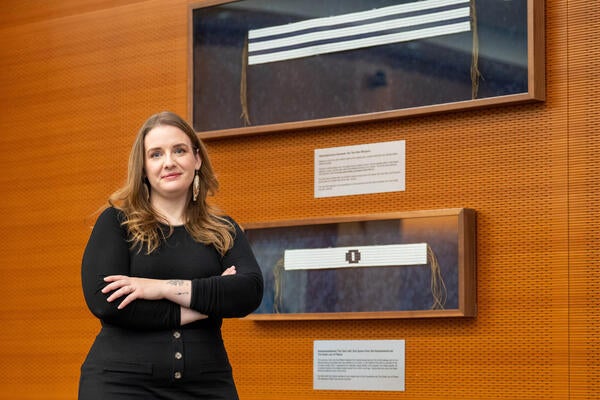
Understanding and changing how we see ourselves
New neurocognitive model for understanding – and changing – how we see ourselves and the world could improve therapies for treating mental health

New neurocognitive model for understanding – and changing – how we see ourselves and the world could improve therapies for treating mental health
By Elizabeth Rogers and Zoe Tipper Faculty of ArtsThroughout our lives, our experiences shape how we view ourselves and the world around us. These views, known in psychology as schemas, can negatively impact our mental health and be difficult to change.
Now, a new model of how we understand these schemas opens doors to new and innovative therapies in mental health treatment.
This model of schema change was developed by Dr. David Moscovitch, professor of Clinical Psychology at the University of Waterloo. and outlines how schemas get updated in the brain by integrating evidence-based findings from the fields of clinical psychology and cognitive neuroscience.
 As a faculty member and clinical psychologist with the Centre for Mental Health Research and Treatment, Moscovitch’s research involves working directly with people who are struggling with their mental health and developing evidence-based psychological treatments to improve their quality of life. His long-time collaborator – and father – Dr. Morris Moscovitch is a renowned expert in memory and professor emeritus in neuropsychology at the University of Toronto. With Dr. Signy Sheldon, a Canada Research Chair in cognitive neuroscience at McGill University, the trio combined their expertise and developed the new neurocognitive model that promises significant advances in the conceptualization and treatment of psychological disorders.
As a faculty member and clinical psychologist with the Centre for Mental Health Research and Treatment, Moscovitch’s research involves working directly with people who are struggling with their mental health and developing evidence-based psychological treatments to improve their quality of life. His long-time collaborator – and father – Dr. Morris Moscovitch is a renowned expert in memory and professor emeritus in neuropsychology at the University of Toronto. With Dr. Signy Sheldon, a Canada Research Chair in cognitive neuroscience at McGill University, the trio combined their expertise and developed the new neurocognitive model that promises significant advances in the conceptualization and treatment of psychological disorders.
“As we began working together it became clear that the world of cognitive neuroscience and the world of clinical psychology have a lot to learn from one another,” said Moscovitch. “We based our ideas on extensive reviews of the scientific literature, my own professional expertise in clinical disorders, cognitive behavioural therapy (CBT), and social anxiety, and my collaborators’ knowledge of memory and the brain, all of which we integrated into our new model.”
Individuals struggling with mental health – such as those with anxiety and depression – often have negative self-schemas that impact how they view themselves and their relationships with others. These negative schemas can go on to create patterns that reinforce harmful beliefs, such as “I am unlovable” or “social interactions are threatening.”
Moscovitch and his collaborators propose that psychological therapies can most effectively treat mental health problems by simultaneously strengthening positive schemas and weakening negative schemas. While past models have focused on weakening negative schemas, Moscovitch’s new model views these processes as complementary and equally essential. Integrated together, these processes create the Schema-Congruent and Schema-Incongruent Learning model, abbreviated as the SCIL model.
Schema-congruent learning encodes new information that is consistent with an adaptive schema and schema-incongruent learning focuses on encoding new information that is inconsistent with a maladaptive schema. By encouraging the simultaneous use of these two processes, the authors believe that clinicians will be able to better support their patients.
The biological foundation of this model focuses on the regions of the brain that encode autobiographical memories, which refer to memories of specific personal experiences that have happened in people’s lives at a specific time and place in the past. The model highlights the role of the hippocampus in directing the autobiographical memory system. Using psychological interventions that mentally simulate personal experiences, the hippocampus can be activated to promote schema change by providing critical information to other regions of the brain where schemas are stored.
“We outline steps clinicians can take when designing and administering clinical interventions so they can be as effective as possible at facilitating schema change” says Moscovitch. “We aim to help clinicians adopt an intentional mindset about what they need to do in therapy in order to guide patients toward the most beneficial mental health outcomes.”
Future research will happen in both the lab and the clinic, notes Moscovitch. Clinicians can work with patients to develop and administer optimally effective evidence-based treatments, and cognitive neuroscientists might think about how best to combine such treatments with newer interventions such as neurofeedback that could help activate the hippocampus more effectively.
“These applied studies would compare the effects of applying the methods we outline in our model against treatment-as-usual to try to isolate the active therapeutic ingredients that account for schema change, both behaviourally and neurally; subsequently, we can investigate the value of incorporating novel neural tools into future treatment protocols.”
The full article, Neurocognitive Model of Schema-Congruent and -Incongruent Learning in Clinical Disorders: Application to Social Anxiety and Beyond, appears in the journal Perspectives on Psychological Science.

Read more
New research from the University of Waterloo centres Haudenosaunee-led efforts in the repatriation and reclamation of cultural and intellectual property

Read more
Researchers awarded funding to investigate ecology, climate change, repatriation, health and well-being through cultural and historical lens

Read more
New Canada Research Chairs will tackle future-focused problems from social robots and intergroup attitudes to geochemistry and nanoscale devices
The University of Waterloo acknowledges that much of our work takes place on the traditional territory of the Neutral, Anishinaabeg, and Haudenosaunee peoples. Our main campus is situated on the Haldimand Tract, the land granted to the Six Nations that includes six miles on each side of the Grand River. Our active work toward reconciliation takes place across our campuses through research, learning, teaching, and community building, and is co-ordinated within the Office of Indigenous Relations.